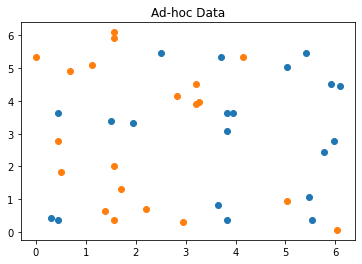Note
This page was generated from tutorials/machine_learning/03_vqc.ipynb.
Run interactively in the IBM Quantum lab.
Variational Quantum Classifier (VQC)¶
The QSVM notebook demonstrated a kernel based approach. This notebook shows a variational method using the VQC algorithm.
For further information see also the following reference, as given in the QSVM notebook, that also describes this approach: “Supervised learning with quantum enhanced feature spaces,” arXiv: 1804.11326
[1]:
import numpy as np
from qiskit import BasicAer
from qiskit.aqua import QuantumInstance, aqua_globals
from qiskit.aqua.algorithms import VQC
from qiskit.aqua.components.optimizers import SPSA
from qiskit.circuit.library import TwoLocal, ZZFeatureMap
from qiskit.aqua.utils import split_dataset_to_data_and_labels, map_label_to_class_name
seed = 10599
aqua_globals.random_seed = seed
As per the QSVM notebook again we will use the ad hoc dataset as described in the above referenced paper. From the dataset we take samples for use as training, testing and the final prediction (datapoints).
[2]:
from qiskit.ml.datasets import ad_hoc_data, sample_ad_hoc_data
feature_dim = 2
sample_total, training_input, test_input, class_labels = ad_hoc_data(
training_size=20,
test_size=10,
n=feature_dim,
gap=0.3,
plot_data=True
)
extra_test_data = sample_ad_hoc_data(sample_total, 10, n=feature_dim)
datapoints, class_to_label = split_dataset_to_data_and_labels(extra_test_data)
print(class_to_label)

{'A': 0, 'B': 1}
With the dataset ready we can setup the VQC algorithm to do a classification. We use the ZZFeatureMap data encoding circuit from the Qiskit circuit library, like we did with QSVM. But this is a variational algorithm so we need a variational form, i.e. parameterized circuit, whose parameters can be varied by an optimizer when computing VQC’s cost function. For this we choose TwoLocal from the Qiskit circuit library. As the qasm_simulator has shot noise we choose to use SPSA which is designed to perform under noisy conditions.
Here the BasicAer qasm_simulator is used with 1024 shots.
[3]:
feature_map = ZZFeatureMap(feature_dimension=feature_dim, reps=2)
optimizer = SPSA(maxiter=40, c0=4.0, skip_calibration=True)
var_form = TwoLocal(feature_dim, ['ry', 'rz'], 'cz', reps=3)
vqc = VQC(optimizer, feature_map, var_form, training_input, test_input, datapoints[0])
backend = BasicAer.get_backend('qasm_simulator')
quantum_instance = QuantumInstance(backend, shots=1024, seed_simulator=seed, seed_transpiler=seed)
result = vqc.run(quantum_instance)
print(f'Testing success ratio: {result["testing_accuracy"]}')
print()
print('Prediction from datapoints set:')
print(f' ground truth: {map_label_to_class_name(datapoints[1], vqc.label_to_class)}')
print(f' prediction: {result["predicted_classes"]}')
predicted_labels = result["predicted_labels"]
print(f' success rate: {100*np.count_nonzero(predicted_labels == datapoints[1])/len(predicted_labels)}%')
Testing success ratio: 0.9
Prediction from datapoints set:
ground truth: ['A', 'A', 'A', 'A', 'A', 'A', 'A', 'A', 'A', 'A', 'B', 'B', 'B', 'B', 'B', 'B', 'B', 'B', 'B', 'B']
prediction: ['A', 'A', 'A', 'A', 'A', 'A', 'A', 'A', 'A', 'A', 'B', 'B', 'B', 'B', 'B', 'B', 'B', 'B', 'B', 'B']
success rate: 100.0%
Now VQC, as well as QSVM, have train, test and predict methods. The run method, as used above, will call these in turn based on whatever data was supplied to the algorithm. But the methods called directly to say train a model and then do predict. Since the vqc instance has already been trained, lets predict another set of sample datapoints by directly calling predict.
[4]:
more_test_data = sample_ad_hoc_data(sample_total, 10, n=feature_dim)
more_datapoints, _ = split_dataset_to_data_and_labels(more_test_data)
predicted_probabilities, predicted_labels = vqc.predict(datapoints[0])
print('Prediction from more_datapoints set:')
print(f' ground truth: {map_label_to_class_name(more_datapoints[1], vqc.label_to_class)}')
print(f' prediction: {map_label_to_class_name(predicted_labels, vqc.label_to_class)}')
print(f' success rate: {100*np.count_nonzero(predicted_labels == more_datapoints[1])/len(predicted_labels)}%')
Prediction from more_datapoints set:
ground truth: ['A', 'A', 'A', 'A', 'A', 'A', 'A', 'A', 'A', 'A', 'B', 'B', 'B', 'B', 'B', 'B', 'B', 'B', 'B', 'B']
prediction: ['A', 'A', 'A', 'A', 'A', 'A', 'A', 'A', 'A', 'A', 'B', 'B', 'B', 'B', 'B', 'B', 'B', 'B', 'B', 'B']
success rate: 100.0%
Finally I will note that the Qiskit classifier algorithms can save_model after training and also load_model that had been previously saved.
[5]:
import qiskit.tools.jupyter
%qiskit_version_table
%qiskit_copyright
Version Information
| Qiskit Software | Version |
|---|---|
| Qiskit | 0.24.1 |
| Terra | 0.16.4 |
| Aer | 0.7.6 |
| Ignis | 0.5.2 |
| Aqua | 0.8.2 |
| IBM Q Provider | 0.12.2 |
| System information | |
| Python | 3.7.7 (default, Apr 22 2020, 19:15:10) [GCC 9.3.0] |
| OS | Linux |
| CPUs | 32 |
| Memory (Gb) | 125.71903228759766 |
| Tue May 25 15:20:21 2021 EDT | |
This code is a part of Qiskit
© Copyright IBM 2017, 2021.
This code is licensed under the Apache License, Version 2.0. You may
obtain a copy of this license in the LICENSE.txt file in the root directory
of this source tree or at http://www.apache.org/licenses/LICENSE-2.0.
Any modifications or derivative works of this code must retain this
copyright notice, and modified files need to carry a notice indicating
that they have been altered from the originals.